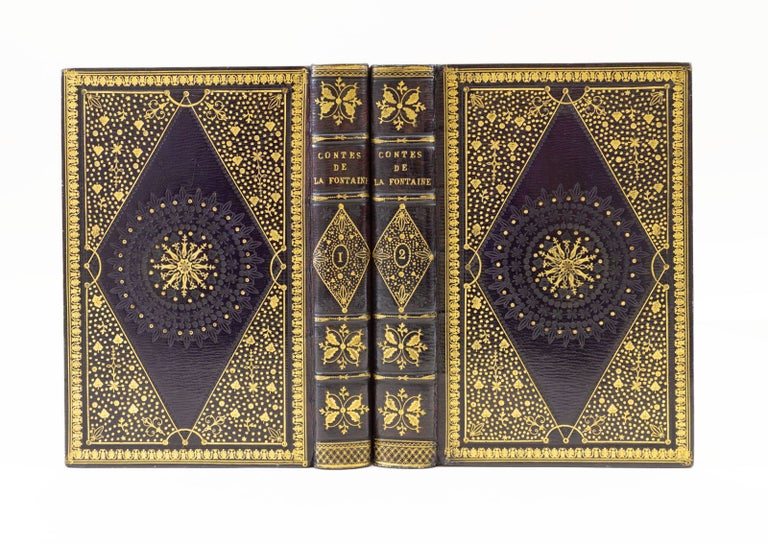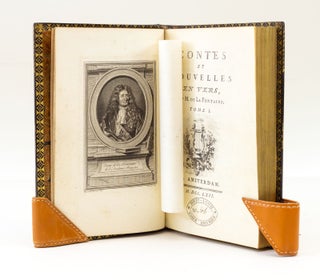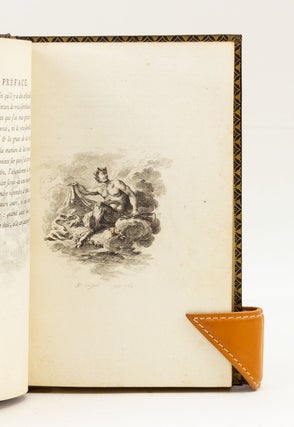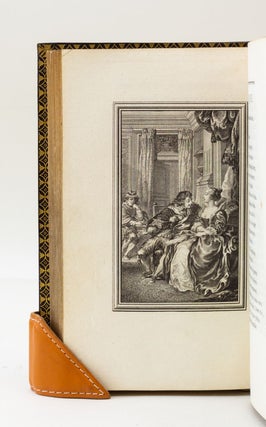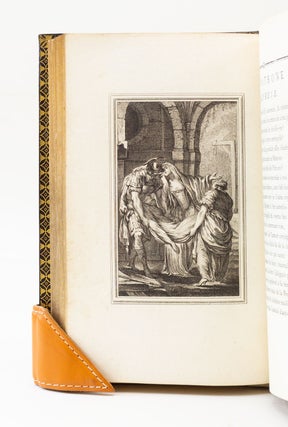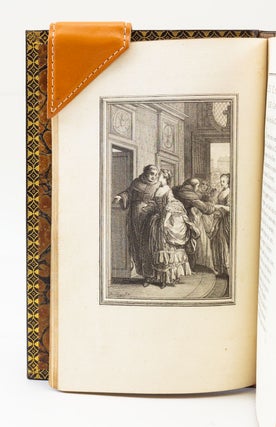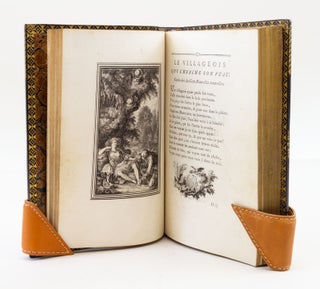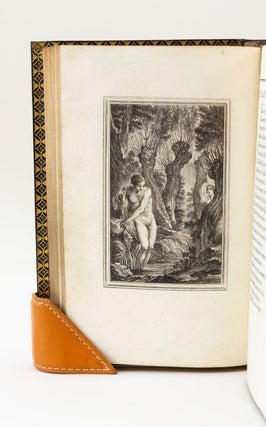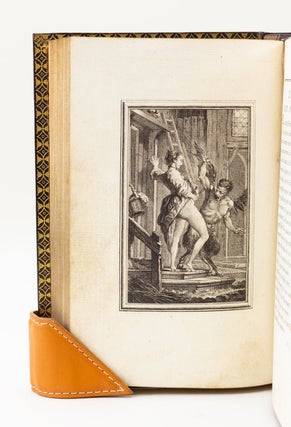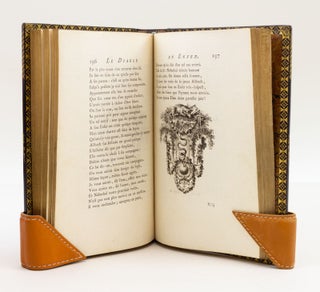CONTES ET NOUVELLES EN VERS.
(Amsterdam [i.e., Paris: Barbou]`, 1762). 182 x 115 mm. (7 1/4 x 4 5/8"). With the often-missing 16-pp. "Avis au relieur" (instructions to the binder), pp. 1-8 at the end of volume I and pp. 9-16 at the end of volume II. Two volumes. First Printing of the Fermiers Généraux Edition, with both "Le Cas de Conscience" and "Le Diable de Papefiguière" in uncovered state.
ELABORATE LATE 18TH OR EARLY 19TH CENTURY DARK PURPLE STRAIGHT-GRAIN MOROCCO, LAVISHLY GILT, covers with cresting palmette roll border flanked by gilt rules enclosing a panel with densely gilt-tooled corners and large central lozenge containing an elaborate "wheel" tooled in gilt and blind, raised bands, spines with one long panel with gilt-tooled lozenge containing the volume number in oval medallion, four smaller panels, one with gilt lettering, the others with large fleuron formed by leaf tools, gilt-rolled turn-ins, marbled endpapers, all edges gilt. SPLENDIDLY ILLUSTRATED WITH two frontispiece portraits of La Fontaine and Eisen, 57 VIGNETTES BY CHOFFARD, and 80 BEAUTIFUL PLATES AFTER CHARLES EISEN, as called for. Front pastedowns with engraved armorial bookplate of John Brymer; title pages with Brymer's ink "Heir-Loom" library stamp. Cohen-de Ricci, cols. 558-70; Ray 26; Brunet III, 759; Tchemerzine VI, 378. ◆Obverse of marbled endleaves slightly browned, minor foxing, small stains, or thumbing, but A FINE SET, the text fresh and wide-margined, the engravings sharp, and THE BINDINGS VIRTUALLY UNWORN AND BRIGHT WITH GILT.
This is an uncommonly fine copy, in a very handsome binding, of one of the most acclaimed illustrated French books of the period, an item that Ray calls "the collector's book 'par excellence.'" Cohen-de Ricci begins 13 columns of description by pronouncing that, "among the illustrated books of the 18th century, this edition . . . as a whole is the most beautiful and the most agreeable." It is also generally accepted as the finest work of Charles Eisen (1720-78), Louis XV's court painter, and drawing master to Madame de Pompadour. Bryan says that "almost all the important books published in France in his time contain his exquisite plates," which "he engraved with a light point and with striking originality." He "took his inspirations direct from nature, but add[ed] something of the ideal, after the manner of Watteau and Boucher." The substantial group of plates here, in Ray's words, is "the liveliest and the most adroit that [Eisen] ever drew. Thoroughly at home with the varied action of these lusty stories--their love passages, their intrigues, their practical jokes--he is also expert in choosing the moment in each that will best serve his purpose as an illustrator." Some 20 of the original engravings were rejected by the publisher, but copies of the work do appear in the marketplace that contain these "figures refusées." A comparison with the listing in Cohen-de Ricci confirms that our copy has the plates as originally published, not the rejected designs. In "La servante justifié," for example, both the man's hands are visible; in "Le calendrier des viellards," there are three people, not five; there is no young man in the doorway of "On ne s'avies jamais de tout"; the woman in "La Clochette" is not wearing a hat; the Abbess in Sœur Jeanne is not standing atop three stairs; there is a basket on the floor in "Comment l'esprit vient aux filles"; the heads of the lovers are touching in "Le Bât"; "Le Cas de Conscience" and "Le Diable de Papefiguière" are both in the more risqué "uncovered" state. The publishers also had two plates--"Le Cocu battu" and "Les Cordeliers"--re-engraved by Longueil; our copy contains the Longueil engravings, which Cohen-de Ricci deems far superior to those signed by Leveau and Baquoy. The very handsome but unsigned bindings show the influence of the Scottish "Wheel" bindings of this period, but with a key difference. The Scottish Wheels were tooled in gilt, with distinct petal-like compartments forming the "spokes." Here, gilt lancet tools radiate from a central octagon, and are encircled by gilt dots, blind-stamped anular dots, floral tools, and an outer rim of blind-stamped fleurs-de-lys alternating with gilt dots. This blind tooling gives the medallion a subtle lacy effect. Our copy was once in the library of John Brymer at Ilsington House in Puddletown, Dorset, an estate that had belonged to Robert Walpole, Earl of Orford, and his heirs; Horace Walpole inherited the manor, but had never lived there, preferring his gothic villa, Strawberry Hill. Brymer, a member of the local gentry, purchased Ilsington from Horace Walpole's heir in 1861, and became the first resident landlord in more than a century. A man whose interest in books extended beyond his own collection, Brymer built an imposing Tudor-style reading room in the village. (ST17002)
Price: $9,500.00

